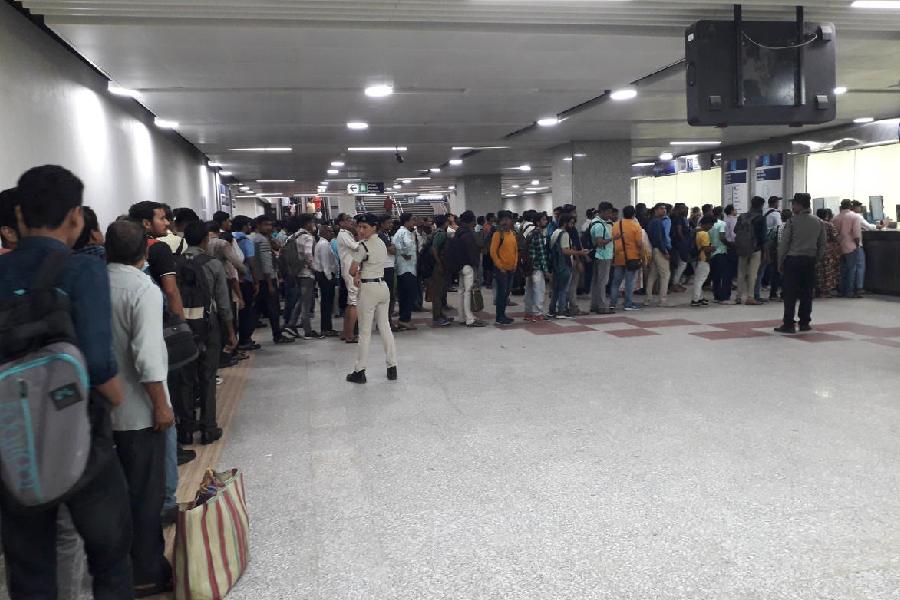Every time a local train arrived at Howrah during the office rush on Monday morning, multitudes of people swarmed the adjacent Metro station hoping for a swift and comfortable ride to the heart of Calcutta.
But many of them faced a common hurdle — a long wait at the crowded ticket counters.
The Howrah station of East-West Metro, India’s deepest and largest Metro station, has a provision for 32 ticket counters. Only six of them were operational during the morning rush.
As a result, each counter had a long queue. Around 10.15am on Monday, the queues in front of the first and last of the six counters were the longest, with over 60 people in each.
In the evening, when the rush was to get back to Howrah from the city, a similar scene was witnessed at the Esplanade and Mahakaran stations in the east-west corridor. Many people were waiting but multiple counters remained non-operational.
Rana Pratap Mukherjee, who works in an information technology company’s Salt Lake office, was waiting at a ticket counter at the Howrah Metro station on Monday morning. Mukherjee had gone home to Raniganj. While returning he took a train to Howrah from Asansol.
He had to wait for close to 12 minutes to get a ticket. “There are so many unmanned counters. During the office rush, the number of counters should be increased,” said Mukherjee, who was headed to the Esplanade Metro station, from where he would switch to the north-south (Blue Line) to go to Sovabazar. From there, he would take surface transport to Salt Lake.
A guard posted at the station said three counters were operational for much of the morning and the number was doubled to handle the peak rush. There were five automated ticket vending machines where some passengers lined up.
Commercial services on the Howrah Maidan-Esplanade stretch of East-West Metro (Green Line), New Garia-Ruby stretch of the New Garia-airport corridor (Orange Line) and the
Taratala-Majerhat section of the Joka-Esplanade corridor (Purple Line) started on March 15. On the Purple Line, trains would run between Joka and Taratala before March 15.
Of the three lines, the Howrah Maidan-Esplanade section is the busiest.
It saw over 70,000 passengers on Friday and over 67,000 on Saturday.
In the run-up to the start of commercial services, Metro Railway had requisitioned staff from various departments of the north-south corridor to manage the rush.
The first three days suggested that the carrier will need more hands.
“There is no staff shortage. The services have just begun. We are monitoring everything. If need be, we will take more people from the Sealdah-Sector V section of East-West Metro or from the north-south corridor (between New Garia and Dakshineswar),” said a Metro official.
Signage
On Monday, this newspaper saw at least two “Green Line” boards — which were not there before — on the platforms of the Esplanade station of the north-south line.
One is near the escalators and stairs leading to gates 3 and 4 and the other near the escalators and stairs leading to gates 1 and 2.
The walkway between the Blue Line and Green Line is opposite gate 4 of the Esplanade station of the former. However, there is no signage in the section of the platform that leads to gates 5, 6 and 7. Many passengers who wanted to take the East-West Metro went towards these three gates, only to be sent back to the other end.
The situation was not different at the Esplanade station of East-West Metro as well. Many passengers who wanted to switch to the north-south line were struggling to find the interface.
The lack of signage at the New Garia station also posed difficulties for many passengers to find their way to the platform for the Dum Dum-bound train. The separate colour codes that guide passengers from the Orange Line to the Blue Line were hard to find.
“Signage cannot be random. There has to be a pattern. Ideally, the direction boards should be near the exit points on the concourse and mezzanine levels. We are working on it. The signage will be much improved within two to three days,” said a senior Metro
official.
